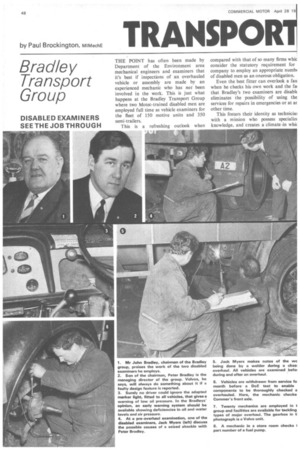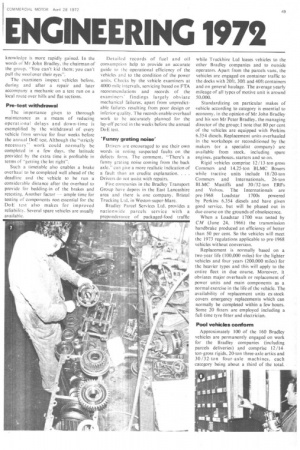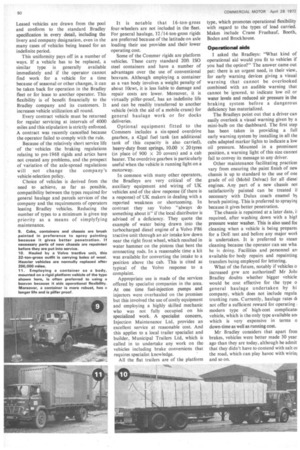TRANSPOR ENGINEERING 1972
Page 50

Page 51

Page 52

If you've noticed an error in this article please click here to report it so we can fix it.
THE POINT has often been made by Department of the Environment area mechanical engineers and examiners that it's best if inspections of an overhauled vehicle or assembly are made by an experienced mechanic who has not been involved in the work. This is just what happens at the Bradley Transport Group where two Motec-trained disabled men are employed full time as vehicle examiners for the fleet of 150 motive units and 350 semi-trailers.
This is a refreshing outlook when
1. Mr John Bradley, chairman of the Bradley group, praises the work of the two disabled examiners he employs.
2. Son of the chairman, Peter Bradley is the managing director of the group. Volvos, he says, will always do something about it if a faulty design feature is reported. 3. Surely no driver could ignore the adapted marker light, fated to all vehicles, that gives a warning of low oil pressure. In the Bradleys' opinion, an early warning system should be available showing deficiencies in oil and water levels and air pressure.
4. At a pre-overhaul examination, one of the disabled examiners, Jack Myers (left) discuss the possible causes of a seized shackle with Peter Bradley.
compared with that of so many firms whic consider the statutory requirement for company to employ an appropriate numb( of disabled men as an onerous obligation.
Even the best fitter can overlook a fau when he checks his own work and the fa' that Bradley's two examiners are disablc eliminates the possibility of using the services for repairs in emergencies or at ar other time.
This fosters their identity as techniciai with a mission who possess specialim knowledge, and creates a climate in whit
5. Jack Myers makes notes of the we being done by a welder during a chat: overhaul. All vehicles are examined befoi during and after an overhaul.
6. Vehicles are withdrawn from service to month before a DoE test to enable components to be thoroughly checked a overhauled. Here, the mechanic checks Commer's front axle.
7. Twenty mechanics are employed in group and facilities are available for tackling types of major overhaul. The gearbox in ti photograph is a Volvo unit.
B. A mechanic in a store room checks part number of a fuel pump.
knowledge is more rapidly gained. In the words of Mr John Bradley, the chairman of the group, "You can't kid them; you can't pull the wool over their eyes-.
The examiners inspect vehicles before, during and after a repair and later accompany a mechanic on a test run on a local route over hills and flat sections.
Pre-test withdrawal
The importance given to thorough maintenance as a means of reducing operational delays and down-time is exemplified by the withdrawal of every vehicle from service for four weeks before the annual DoE test. Although the "strictly necessary" work could normally be completed in a few days. the latitude provided by the extra time is profitable in terms of "getting the lot right".
Such a timetable also enables a brake overhaul to be completed well ahead of the deadline and the vehicle to be run a considerable distance after the overhaul to provide for bedding-in of the brakes and retesting. Another factor -ample time for testing of components non-essential for the DoE test also makes for improved reliability. Several spare vehicles are usually available.
Detailed records of fuel and oil consumption help to provide an accurate guide to the operational efficiency of the vehicles and to the condition of the power units. Checks by the vehicle examiners at 4000-mile intervals. servicing based on FTA recommendations and records of the examiners' findings largely obviate mechanical failures, apart from unpredictable failures resulting from poor design or inferior quality. The records enable overhaul work to he accurately planned for the lay-off period in the weeks before the annual DoE test.
'Funny grating noise' Drivers are encouraged to use their own words in noting suspected faults on the defects form. The comment. "There's a funny grating noise coming from the back axle.can give a more realistic indication of a fault than an erudite explanation. . . . Drivers do not assist with repairs.
Five companies in the Bradley Transport Group have depots in the East Lancashire area and /here is one company, Bristol Trucking Ltd, in Weston-super-Mare.
Bradley Parcel Services Ltd. provides a nationwide parcels service with a preponderance of packaged-food traffic while Truckhire Ltd leases vehicles to the other Bradley companies and to outside operators. Apart from the parcels vans, the vehicles are engaged on container traffic to the docks with 20ft, 30ft and 40ft containers and on general haulage. The average yearly mileage of all types of motive unit is around 50,000.
Standardizing on particular makes of -vehicle according to category is essential to economy, in the opinion of Mr John Bradley and his son Mr Peter Bradley, the managing director of the group; I note that 80 per cent of the vehicles are equipped with Perkins 6.354 diesels. Replacement units overhauled in the workshops or reconditioned by the makers (or a specialist company) are available from stock. including spare engines, gearboxes starters and so on.
Rigid vehicles comprise 12 / 13-ton-gross Commers and 14.25-ton BLMC Boxers while tractive units include 18/20-ton Commers and Internationals, 26-ton BLMC Mastiffs and 30/32-ton ERFs and Volvos. The Internationals are pre-1968 Load star 1700s powered by Perkins 6.354 diesels and have given good service, but will be phased out in due course on the grounds of obsolescence.
When a Loadstar 1700 was tested by CM (June 24, 1966) the transmission handbrake produced an efficiency of better than 50 per cent. So the vehicles will meet the 1973 regulations applicable to pre-1968 vehicles without conversion.
Replacement is normally based on a two-year life (100,000 miles) for the lighter vehicles and four years (200,000 miles) for the heavier types and this will apply to the entire fleet in due course. Moreover, it obviates major overhauls or replacement of power units and main components as a normal exercise in the life of the vehicle. The availability of replacement units ex-stock covers emergency replacements which can normally be completed within a few hours. Some 20 fitters are employed including a full-time tyre fitter and electrician.
Pool vehicles conform
Approximately 100 of the 160 Bradley vehicles are permanently engaged on work for the Bradley companies (including parcels deliveries) and comprise 12 /14ton-gross rigids, 20-ton three-axle artics and 30/32-ton four-axle machines, each category being about a third of the total.
Leased vehicles are drawn from the pool and conform to the standard Bradley specification in every detail, including the livery and company designation, even in the many cases of vehicles being leased for an indefinite period.
This uniformity pays off in a number of ways. If a vehicle has to be replaced, a similar type is generally available immediately and if the operator cannot find work for a vehicle for a time because of seasonal or other changes, it can be taken back for operation in the Bradley fleet or for lease to another operator. This flexibility is of benefit financially to the Bradley company and its customers. It increases vehicle utilization all round.
Every contract vehicle must be returned for regular servicing at intervals of 4000 miles and this stipulation is strictly enforced. A contract was recently cancelled because the operator failed to comply with the rule.
Because of the relatively short service life of the vehicles the braking regulations relating to pre-1968 rigids and artics have not created any problems, and the prospect of variation of the axle-spread regulations will not change the company's• vehicle-selection policy.
Choice of vehicles is derived from the need to achieve, as far as possible, compatibility between the types required for general haulage and parcels services of the company and the requirements of operators leasing Bradley vehicles. Reducing the number of types to a minimum is given top priority as a means of simplyfying maintenance.
9. Cabs, containers and chassis are brush painted in preference to spray painting because it gives better penetration. If necessary parts of new chassis are repainted before they are put into service.
10. Hauled by a Volvo tractive unit, this 32-ton-gross outfit is carrying bales of wool. Heavier vehicles are normally replaced after 200,000 miles.
11. Employing a container as a body, mounted on a rigid platform vehicle of the type shown here, is often preferred to using a boxvan because it aids operational flexibility. Moreover, a container is more robust has a longer life and is pilfer proof.
It is notable that 16-ton-gross four-wheelers are not included in the fleet. For general haulage, 12 /14-ton-gross rigids are preferred because of the latitude on axle loading their use provides and their lower operating cost.
Some of the Commer rigids are platform vehicles. These carry standard 20ft ISO steel containers and have a number of advantages over the use of conventional boxvans. Although employing a container as a van body involves a weight penalty of about lOcwt, it is less liable to damage and repair costs are lower. Moreover, it is virtually pilfer-proof, has an indefinite life and can be readily transferred to another vehicle (with the aid of a mobile crane) for general haulage work or for docks deliveries.
Optional equipment fitted to the Commers includes a six-speed overdrive gearbox, a 42ga1 fuel tank (an additional tank of this capacity is also carried), heavy-duty front springs, 10.00 X 20 tyres (in place of 900 x 20 covers) and a cab heater. The overdrive gearbox is particularly useful when the vehicle is running light on a motorway.
In common with many other operators, the Bradleys are very critical of the auxiliary equipment and wiring of UK vehicles and of the slow response (if there is a response) of UK makers in dealing with a reported weakness or shortcoming. In contrast they say Volvo "always do something about it" if the local distributor is advised of a deficiency. They quote the example of water being drawn into the turbocharged diesel engine of a Volvo F86 tractive unit through an air intake low down near the right front wheel, which resulted in water hammer on the pistons that bent the connecting rods. In a reasonable time a kit was available for converting the intake to a position above the cab. This is cited as typical of the Volvo response to a complaint.
Appropriate use is made of the services offered by specialist companies in the area. At one time fuel-injection pumps and injectors were overhauled on the premises but this involved the use of costly equipment and employing a highly skilled mechanic who was not fully occupied on his specialized work. A specialist concern, Injection Maintenance Ltd, provides an excellent service at reasonable cost. And this applies to a local trailer specialist and builder, Municipal Trailers Ltd, which is called in to undertake any work on the vehicles including brake conversions that requires specialist knowledge.
All the flat trailers are of the platform type, which promotes operational flexibility with regard to the types of load carried. Makes include Crane Fruehauf, Booth, Boden and Brockhouse.
Operational aids
I asked the Bradleys: "What kind of operational aid would you fit to vehicles if you had the option?" The answer came out pat: there is an urgent need, in their view, for early warning devices giving a visual warning that cannot be overlooked combined with an audible warning that cannot be ignored, to indicate low oil or water levels and reduced air pressure in the braking system before a dangerous deficiency has materialized.
The Bradleys point out that a driver can easily overlook a visual warning given by a mini-bulb on the dashboard. The first step has been taken in providing a full early warning system by installing in all the cabs adapted marker lights to indicate a low oil pressure. Mounted in a prominent position, a warning light of this size cannot fail to convey its message to any driver.
Other maintenance facilitating practices vary from ensuring the paint finish of new chassis is up to standard to the use of one grade of oil (Mobil Delvac) for all diesel engines. Any part of a new chassis no1 satisfactorily painted can be treated il necessary with Dulux coach enamel by brush painting. This is preferred to spraying because it gives better penetration.
The chassis is repainted at a later date, ii required, after washing down with a higl pressure water washer. This is also used for cleaning when a vehicle is being prepare( for a DoE test and before any major worl is undertaken. It is preferred to stean cleaning because the operator can see wha he is doing. Facilities and personnel an available for body repairs and repainting transfers being employed for lettering.
What of the future, notably if vehicles o increased gvw are authorized? Mr Joh' Bradley doubts whether bigger vehicle would be cost effective for the type o general haulage undertaken by hi company, which does not include regula trunking runs. Currently, haulage rates ck not offer a sufficient reward for operating . modern type of high-cost complicate' vehicle, which is the only type available am which is very expensive in terms o down-time as well as running cost.
Mr Bradley considers that apart fron brakes, vehicles were better made 30 year ago than they are today, although he admit that they didn't have to contend with salt oi the road, which can play havoc with wirin; and so on.








































































































